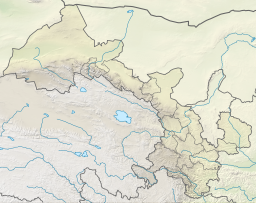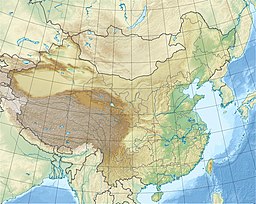geo.wikisort.org - Reservoir
Yueyaquan (Chinese: 月牙泉; pinyin: Yuèyá Quán) is a crescent-shaped lake in an oasis, 6 km south of the city of Dunhuang in Gansu Province, China.
This article needs additional citations for verification. (May 2013) |
| Yueyaquan | |
|---|---|
| Crescent Lake | |
 The lake and pavilion in 2015 | |
| Location | Gansu |
| Coordinates | 40°5′12″N 94°40′10″E |
| Native name | 月牙泉 (Chinese) |
| Basin countries | China |
| Surface area | 1.37 acres (0.55 ha) |
| Average depth | 4–5 m (1960) 0.9 m (1990s) |
| Max. depth | 7.5 m (1960) 1.3 m (1990s) |
History
The lake was named Yueyaquan in the Qing Dynasty. Mildred Cable and Francesca French visited the lake during their travels in the region in 1932 and recorded their impressions in their book The Gobi Desert: "All around us we saw tier on tier of lofty sand-hills, giving the lie to our quest, yet when, with a final desperate effort, we hoisted ourselves over the last ridge and looked down on what lay beyond, we saw the lake below, and its beauty was entrancing."[1]
According to measurements made in 1960, the average depth of the lake was 4 to 5 metres (13 to 16 ft), with a maximum depth of 7.5 metres (25 ft). In the following 40 years, the depth of the lake declined by more than 7.6 metres (25 ft).[2] In the early 1990s, it had shrunk to an average depth of one meter. In 2006, the local government with help of the central government started to fill the lake and restore its depth; its depth and size have been growing yearly since then.[3] Proposed groundwater diversions are modeled to raise the water table and level of the lake.[4]
The lake and the surrounding deserts are very popular with tourists, who are offered camel and all-terrain vehicle rides.[5]
References
- Cable, Mildred; French, Francesca (1950). The Gobi Desert. London: Readers Union & Hodder and Stoughton. p. 63.
- Yardley, Jim (27 May 2005). "A Crescent of Water is Slowly Sinking into the Desert". The New York Times.
- "China's tiny desert oasis Yueyaquan Crescent Lake saved from a future". 15 May 2013.
- Lin, Jingjing; Ma, Rui; Hu, Yalu; Sun, Ziyong; Wang, Yanxin; McCarter, Colin P. R. (2018). "Groundwater sustainability and groundwater/Surface-water interaction in arid Dunhuang Basin, northwest China". Hydrogeology Journal. 26 (5): 1559–1572. Bibcode:2018HydJ...26.1559L. doi:10.1007/s10040-018-1743-0. S2CID 134958513.
- "In China's Land of Buddhas and Fortresses, Kindness Prevails". The New York Times. November 27, 2018.
На других языках
[de] Yueya Quan
Yueya Quan (chinesisch .mw-parser-output .Hani{font-size:110%}月牙泉, Pinyin Yuèyá Quán – „Mondsichelquelle“), auch: Mondsichelsee, ist ein halbmondförmiger See in einer 6 km südlich der Stadt Dunhuang in der chinesischen Provinz Gansu befindlichen Oase, die von hohen Dünen umgeben ist. Sie trägt ihren Namen seit der Qing-Dynastie. Sie ist benachbart mit den bis zu 300 m hohen sogenannten "widerhallenden", oder "singenden" Sanddünen (Mingsha Shan) der Kumtag-Wüste, die Bestandteil der Taklamakan-Wüste ist. Als Oase war sie wichtiger Anlaufpunkt für Reisende auf der Seidenstraße.- [en] Crescent Lake (Dunhuang)
[fr] Yueyaquan
Le Yueyaquan (chinois : 月牙泉 ; pinyin : Yuèyá Quán) est un lac chinois en forme de croissant de lune situé sur le territoire de la ville de Dunhuang, dans la province du Gansu.[ru] Юэяцюань
Юэяцюань (кит. упр. 月牙泉, пиньинь Yuèyáquán) — озеро в форме полумесяца в оазисе Дуньхуан, в 5 км к юго-западу от города Дуньхуан (провинция Ганьсу, КНР).Другой контент может иметь иную лицензию. Перед использованием материалов сайта WikiSort.org внимательно изучите правила лицензирования конкретных элементов наполнения сайта.
WikiSort.org - проект по пересортировке и дополнению контента Википедии

